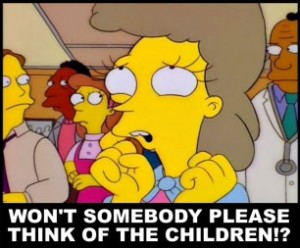Resident breastplate-nipple Gil Kerlikowski and Prohibitionist Jr. Woodchuck Kevin Sabet have reacted in truly glorious form to the new teen drug use survey, citing a statistically miniscule annual increase in teens who have smoked in the last year as irrefutable evidence that MMJ and the end of prohibition are purely to blame for this increase. What they aren’t eager to talk about is that same survey revealing that teen alcohol and cigarette use is noticeably down as is synthetic marijuana usage and most other drugs across the board. A question for the parents out there: If the tiniest increase in marijuana use among teens means a significant decline in alcohol, cigarettes, and synthetics (you know, the stuff that actually can kill you), are you cool with that? As a parent, I say a resounding hell yes.
Furthermore, I would argue that use hasn’t likely increased as much as it appears, just the level of open admission to said use. In a country where over half of adults think pot should be legal, 20 states that have MMJ and two that have outright legalized it, it’s only natural for teens who would have previously lied to hide their smoking to feel much safer and more accepted when admitting it. Also, I would think that some of those teens who are not drinking or smoking tobacco anymore have opted instead for marijuana, which I would prefer as a parent. I know that when I was a teenager, I was most certainly not honest about my alcohol/pot use–even if I was assured it was an anonymous survey. It also ocurrs to me that if I was a teenager and trying to protect my dealer (or myself) I would happily tell people that I “know someone with a green card.”
While there is likely some telling data to be mined from such a survey, it is bound by the respondee’s perceptions and biases. There is no yardstick by which all can be measured equally. I have a friend who uses medical cannabis. She hardly needs any at all, I’m talking in the realm of one pot gummi a day. Myself, on the other hand, smoke a decent amount of cannabis per use. On a survey, both of us would have to check “use daily.” Surveys have a strong tendency to be innaccurate and the questions are often written in such a way as to shape the answers. This may be more prevalent in political polls, but the bias carries over regardless when you are essentially trying to mathematically quantify an opinion held by an individual. Anyone remember the polls that came out during the final push of the last election cycle? Romney was all but guaranteed victory in some. We all kow how true that data ended up being.
In an ideal world, no teen or child will use any form of drug recreationally. But we just don’t (never have) live in that world. Some teens are just going to seek out substances, others may be curious, and still others will never even sip a beer while still a teen. Select any generation and you will find that is true, with the main variance being which substance they use. The same phenomenon can been seen with the onset of Rock and Roll. Some kids fully embraced it, others kind of liked it, and some fully rejected it. Also, Rock and Roll was vilified to no end and equated with satanic worship by people who simply didn’t understand it and spoke from a place of historical authority. It was new, the established powers didn’t like it and they fought hard to squelch it from existence. Sound familiar? Hey, Gil and Kev-O, that’s your cue!

Kerlikowsi and Sabet have their heads so far up their asses that they only have to eat every other day.
The numbers they are reporting are not the complete picture. To borrow a quote from StoptheDrugWar.org’s Philip Smith:
“It helps to put those numbers in historical perspective. All of the numbers are above the historic lows in teen drug use reported at the end of the Reagan-Bush era in the early 1990s, but well below the historic highs in teen drug use reported in 1979, just before the Reagan-Bush era began. For seniors, the all-time low for monthly use was 11.9% in 1992, but the recent high was 23.1% in 1999. This year’s 22.7% is actually a decline of two-tenths of a percent from 2012, and in line with figures for the past decade showing rates hovering in the upper teens and low twenties. It’s a similar story at the younger grade levels.”
A complete picture doesn’t bolster their argument nearly as much as cherry-picked and skewed data. Please read Smith’s article to see a more in-depth breakdown of the numbers. Also, check here for a much more thorough analysis of teen smoking in MMJ states.
Kerlikowski believes (or at least spouts off like he does) that living in a state that allows MMJ makes it easier for teens to get it. Seawater is also way easier to get in California than in Ohio. Of course its easier in states that have some form of decriminalized cannabis to get cannabis. Duh. Remove MMJ and reinstall prohibition and you will not see much of a shift in teen smoking, just a decrease in accurate reporting. As Smith mentioned, teen cannabis use peaked at its all time high in the 1979, in the hay days of prohibition and long before the MMJ industry was born.

Another of Golden Gil’s complaints is the growing perception among teens that marijuana is not harmful or addictive. Guess what, soon-to-be ex drug czar? The teens are correct and they are backed by that untrustworthy bastard named “science.” How can we honestly expect 10th and 12th graders not to mirror at least some of the popular opinion regarding cannabis? I think it’s safe to assume some of that majority of American adults who believe cannabis should be legal are the parents of these teens. It’s only natural for them to feel like pot is less harmful and addictive considering the deluge of positive media that cannabis has garnered in recent months. From seeing how safe and effective it is as medication to it’s historically non-existent OD numbers and its potential to boost the economy, these teens would be exhibiting a lack of intelligence if they adhered to the same stale old talking points that Gildo and Sabetron keep shoveling in their faces. I remember that a large portion of my 12th grade academic experience was learning about the state of the world into which I would soon be entering. It involved reading the news, watching documentaries, and studying history. If these teens are even remotely paying attention, they have to be at least moderately exposed to such media.
It is not MMJ or the end of prohibition that is affecting how teens view marijuana. The collective global opinion on cannabis is shifting, and relatively quickly, too. It is a new world for cannabis. A new world in which these teens are going to become prime stakeholders. Teens are not dumb, they are young, lack exposure and experience, but their mental acuity is such that they have to try to reconcile the “facts” that they have been force-fed for years with the scientific and anecdotal evidence that is all over the media these days. In that attempt at reconciliation, they come to the same impasse that adults reach: a wide canyon exists between the truth and propaganda.
The issue remains unchanged in my eyes. Parents need to be parents and take an active role in guiding their children to positive choices. Prohibiting marijuana or blaming MMJ does nothing to the fact that a sizable amount of minors (and people in general) are going to be drawn to some form of substance. If we can agree that this phenomenon is real and that X amount of any given generation will seek out some form of drug, I, for one, am much more comfortable with teens experimenting with cannabis (which could not kill even the most self-destructive and thoughtless teen). Again, I put it to the parents. Which phone call do would you rather get from a cop at 2am: “Your child is in the hospital fighting for his/her life after getting alcohol poisoning” or “Please come pick up your child, we brought him in after he was found eating a bag of Cheetos in the park after hours.”
Look, truthfully, I’d rather not get any phone calls about my sons from the police. But given that underage substance use is not going anywhere anytime soon (likely ever) and kids will be kids and sometimes make poor choices, I’m comforted by the fact that more young people are choosing grass over the actually dangerous narcotics. Ask any mother out there who lost her child in a drunk driving accident or to an overdose and they would tell you that losing them is exponentially, infinitely worse than having a kid who likes weed.
Be involved in your child’s life. Be honest with them and allow them a safe atmosphere in which to ask questions and share their thoughts. I watched a lot of my friends drink way, way too much. Without fail, they had draconian (prohibitionist) parents who strictly forbade even trying a beer. I also saw a lot of those friends go too far. Some made it out okay, some ended up injured and a couple I know actually died from alcohol poisoning.
My parents didn’t encourage me to drink, but when I was curious they just leveled with me and let me try a little sip or have a whole beer on thanksgiving. I grew up with a non combative, non-rebellious relationship with booze and my parents. In high school if I planned on drinking, I told my parents and they just wanted to make sure I didn’t drive. They showed how to have a responsible relationship with alcohol. Cannabis is not going anywhere no matter how hard some will try to banish it to the Phantom Zone with General Zod. Let’s model how to have responsible relationships with substances.
Let’s share the word and keep spreading genuine truth. Enough drops of water can make a tidal wave.









